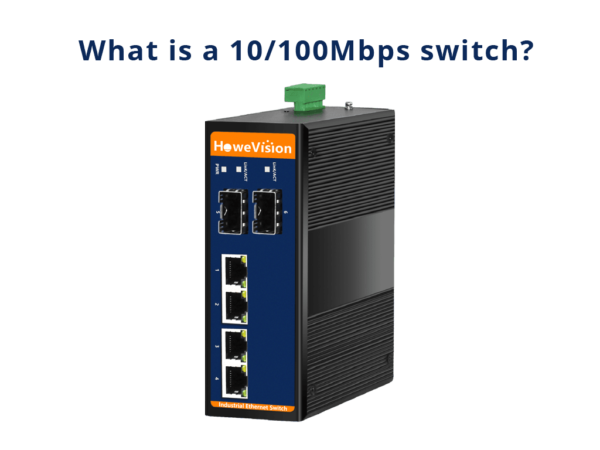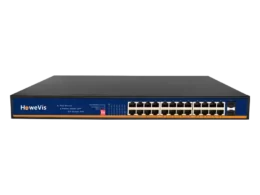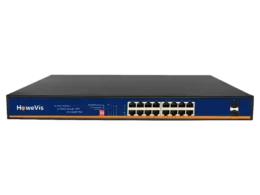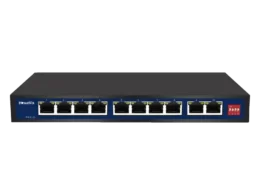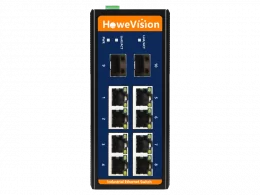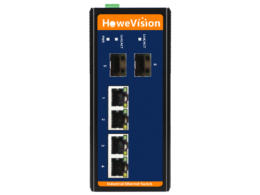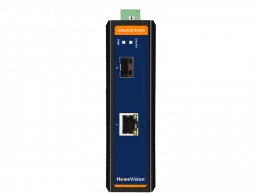In offices, you need two things.
- Power Supply
- Data connection
How do you get both of these? By employing some unique mechanisms, right? I want to ask, Are you using a separate system for both the power supply and data connection? I mean WiFi networks for data connection and multiple ports to power your devices. Isn’t it expensive and insecure? Being a better alternative, we can use Ethernet. It offers both power and data supply over the same Ethernet port, many advantages related to expenses, and high-speed data and power supply.
Ethernet comes in different varieties. For example, “Fast Ethernet and Gigabit Ethernet.” Both vary depending on the speed and several other factors. If you want to look at the difference between both, read the guide—What Is Fast Ethernet and Gigabit Ethernet?
Origin of 10/100Mbps Switch:
At home or office, you might have observed some switches. A label of 10/100Mbps is visible on them. Do you know what exactly it is? What is the type of switch? As a beginner, it is always problematic for you. No worries, I can disclose the background and kind of switch.
In 1995, the Institute of Electrical and Electronics Engineering(IEEE) developed a system for fast internet connection. The quickest system works over the Ethernet ports and offers data speed up to 100 MBs per second. So, we call it Fast Ethernet technology. Another name is 10/100Mbps Ethernet. It works based on the rules of the 802.3u standard.
What is a 10/100 switch?
As above, I suppose it is no longer challenging to define the 10/100Mbps switch.
A Fast Ethernet switch or 10/100 MBps switch is a network switch that connects multiple devices and provides them with a high data speed of up to 100 MBs per second. In 1995, this was a revolution in the data industry with a high-speed connection. Later on, in 1999, Gigabit Ethernet just replaced the fast Ethernet. But, still, it is suitable for small networks requiring low data speeds of up to 100 MBs per second. Today, we will have a detailed overview of Fast Ethernet.
How does a 10/100Mbps Ethernet switch work?
No need for a unique mechanism to apply. Simple process. There are two options available on switch— one for 10Mbps and another for 100Mbps. You require two hubs.
- 10 BaseT hub
- 100 BaseTX hub
You need to link the switch with the relevant Ethernet hub. From the switch, 10 Base-T hubs will connect networks over LAN and provide them with data speed up to 10 MBs per second. At the same time, 100 Base-TX hubs will come up with higher speeds of up to 100 Mbps. That’s why we call this switch 10/100Mbps Ethernet switch.
What are the different types of Fast Ethernet?
Like Gigabit Ethernet technology, Fast Ethernet switches come in different varieties with different ranges. You know, why all these types? Because every system has its compatibility and requires different data speeds and ranges. So, depending on your choice, you can go for any of the Fast Ethernet types.
Here are three basic types of Fast Ethernet.
- 100 Base-TX
- 100 Base-FX
- 100 Base-T4
The term “100” indicates the data speed— 100 MBs per second.
100 Base-TX:
One of the most popular types of Fast Ethernet is 100 Base-TX. It works over the two pairs of Unshielded Twisted Pairs (UTP) and two pairs of Shielded Twisted Pairs (STP) of the Cat5 Ethernet port. Each pair of the port works in each direction, providing a full-duplex feature over the network. 100 Base-TX procures the following parts.
- Works within the range of 100 meters of the connection.
- Employs MLT-3 as a final encoding of the data stream.
- The fundamental frequency is up to 31.25 MHz.
- Use of twisted wires of copper
100 Base-FX:
Another type of 10/100Mbps switch is 100 Base-FX. A bit different from the first one due to the use of types of ports. Unlike four pairs of ports, it contains two pairs of fiber optic cables. One pair carries the frame from the station to the hub, and the second does the opposite job. It has the following points worth discussing.
- Use of fiber optic instead of copper wires
- Data speed up to 10MBs per second. Suitable for smaller systems requiring low-speed data like industrial automation plants.
- Uses an NRZ-1 encoding scheme.
- Range up to 2 kilometers
100 Base-T4:
The third type of 10/100 switch is 100 Base-T4. It employs four pairs of Cat3 Ethernet ports of unshielded twisted pair(UTP) variety. Out of four pairs, two are bi-directional while the other two are unidirectional. Like other types, it has the following peculiar features.
- Use of twisted copper wires
- 8B/6T encoding scheme
- Each twisted pair handles only 25 Mbaud.
What are the advantages of 10/100 Ethernet switch?
10/100 Ethernet switch comes with numerous advantages. In 1995, this was the fastest technology providing a speed up to 100 MBs per second. Nowadays, you can find Gigabit Ethernet as an alternative. However, it is still in use. Here are the advantages of 10/100 switch.
High Performance of Network:
The performance of networks matters. Do you know, why? Because it prevents domain collisions and reduces the traffic for smooth work. Though the speed is up to 100 MBs per second, it uses 5 or 8 10/100Base-TX RJ-45 ports to improve efficiency quickly. For home networks, it is a better option with high speed and performance of the network.
Easy to Set:
Plug and play. No need to install drivers or purchase unique systems. Even you don’t have to hire any IT specialists. Impressive, right? You need the switch, hubs, and computer networks. That’s all. You can plug the wires in the switch and get the data speed through the Ethernet hubs. If you need 10 MBs per second speed, you have a separate socket. For 100 MBs per double speed, you can find a different option. Depending on your requirements, you can come up with the relevant decision.
Low Cost:
Compared to Gigabyte Ethernet or other options, you don’t have to spend more money. It is even four times cheaper than the Gigabit switch. You can save your budget on its cost, and you don’t have to hire IT experts. Compact design makes it consume less space and come up with the perfect solution at such a low cost. Quite incredible!
High-speed data for simple data works:
You can commonly find the use of Fast Ethernet. Amazingly, it is even more popular than Gigabit Ethernet. Do you know, why? Because most of the systems at the office or home require a maximum speed of up to 100 MBs per second. Moreover, it is best for graphics-related work, video streaming, and internet surfing tasks.

